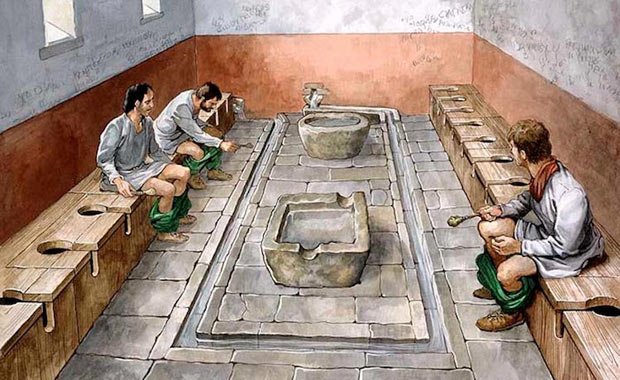Eski insanlar tuvaletlerini nasıl yapıyorlardı?
How were they doing old people's toilets?

İnsanlar tarihlerinde çok uzun bir süre tuvalet kullanmadılar. Başlangıçta hayvanlar nasıl yapıyorlarsa, onlar da öyle yaptılar. İşlerini en yakın çalının dibinde veya bir ırmak kenarında görebiliyorlardı. Ancak toplumlar geliştikçe, köyler, kasabalar ortaya çıktıkça tuvalet ihtiyacını karşılamak için daha uzak mesafelere gitme zorunluluğu doğdu. Ayrıca açıkta bırakılan atıkların yarattığı kötü koku ve hastalık tehlikeleri de insanlarda bu konuda bazı önlemler almanın zamanının geldiği bilincini oluşturdu.Binlerce yıl önce Sümerler, Mısırlılar ve Hindistan'da yaşayanlar oturakta oturup, ihtiyaçlarını giderdikten sonra oturağa düşenleri uzakta bir yerlere döküyorlardı. İki bin yıl önce ise Romalılar ilk basit tuvaleti kullanmaya başladılar. Atıklar oturdukları deliğin içine düşüyor, deliğin altından akan su onları uzağa taşıyordu.
Çiftçilerin, açık arazide çalışanların ise zaten böyle bir dertleri yoktu. Tarlanın bir köşesine çukur kazıyor, çukur yeterince dolunca, toprakla dolduruyor ve başka bir çukur kazıyorlardı. Geceleri ise yataklarının altında bir lazımlık bulunduruyorlardı.
Ortaçağda kale ve şatolarda atık bir delik vasıtası ile binanın etrafındaki su birikintisine düşürülüyordu. Bir yere tuvaletini yapıp, onu bir tanktan gelen su ile sürükleyip, uygun bir yere bırakma fikri ilk olarak Kraliçe 1. Elizabeth zamanında, 1589 yılında John Harrington'dan geldi. Ancak o zamanlar İngiltere'deki evlerde ne böyle bir tankı dolduracak, ne de atığı alıp götürecek su sistemi vardı.
Günümüzdekilere benzer bir tuvalet ancak iki yüzyıl sonra 1778'de İngiltere'de bir saat yapımcısı olan Alexander Cumming tarafından tasarlandı ve Joseph Bramah tarafından geliştirildi. Tuvaletlerden evlere yayılan kötü koku ise 1849 yılında Stephen Green'in 'U' şeklinde bir boruyu tuvaletin çıkışına monte etmesi ile son buldu. Tuvaletlerin ve günümüzde lavaboların da altında bulunan bu 'U' şeklindeki boruda her zaman bir miktar su kalır ve kokunun oluşmasını önler. Tabii o zamanlar tuvaletler dökme demirden yapılıyordu. Sonra düzgün yüzeylerinin temizlenme kolaylığı bakımından seramik tuvaletler üretilmeye başlanıldı. 1888 yılında ise tuvaletlere zinciri çekilince suyu akan klozetler ilave edildi.
Bizde tuvaletler için hela, kenef, ayakyolu, WC., 00, yüznumara gibi birçok isim kullanılır. 'WC.' İngilizce ismindeki 'Water Closet'in baş harfleridir. Yüznumaranın hikayesi ise değişik. Eskiden Fransa'da otellerde tuvaletler koridorların uçlarındaydı. Odaların her birine birer numara verirken, tuvaletlere numarasız demişler ve '00' diye işaretlemişlerdi. Fransızca'daki 'numarasız' kelimesi ile '100 numara' kelimesi hemen hemen aynı telaffuz edildiğinden, bizde Fransızcası biraz kıt birinin tercüme hatası sonucu 'yüznumara' olarak yerleşmiştir.
How were they doing old people's toilets?

People have not used toilet in their history for a very long time. At the beginning, animals do so, they do. They could see their work at the bottom of the nearest bush or at the edge of a river. But as societies developed, the villagers had to go further distances to meet their toilet needs as towns emerged. In addition, the dangers of bad odors and illnesses created by exposed wastes also became the awareness of the time when people had to take some precautions in this regard. Many years ago, the Sumerians, Egyptians and India residents were sitting in the car, pouring their necessities away. Two thousand years ago, the Romans began to use the first simple toilet. The wastes fell into the hole where they lived, the water running underneath the hole carried them away.
The farmers, the open-minded workers, did not have such problems anyway. They were digging a hole in a corner of the field, filling the pit full enough, filling it with soil and digging another pit. The nights were holding a pot under their beds.
In the middle ages, the water around the building was reduced by a waste hole in the castle and chateaux. The idea of making a toilet one time, dragging it from a tank and leaving it to a suitable place first came from John Harrington in 1589, during the time of Queen Elizabeth II. But at that time there was a water system in England that would neither fill a tank nor take a wasteland.
A toilet similar to ours was designed by Alexander Cumming, a watchmaker in England in 1778 two centuries later, and was developed by Joseph Bramah. The bad smell spreading from the toilets to the house ended in 1849 when Stephen Green installed a "U" shaped pipe at the exit of the toilet. These 'U' shaped pipes, which are under the toilet and today's sinks, always have some water remaining and prevent the formation of odor. Of course the toilets were made of cast iron at that time. Then ceramic toilets were started to be produced for the cleanliness of smooth surfaces. In 1888, toilets were added to the water closets that flowed water.
We have many names for toilets such as hela, kenef, footyolu, WC, 00, facenumara. 'WC.' It is the initials of 'Water Closet' in English name. The story of the face is different. In the past, in France, the toilets in the hotels were in the corridors. When they gave each room a number, they spoke untouched to the toilets and labeled '00'. Since the word "numberless" in French and "number 100" are pronounced almost the same, we have settled as a result of the translation mistake of a Frenchman who is a bit scarce.
Hi! I am a robot. I just upvoted you! I found similar content that readers might be interested in:
https://www.facebook.com/gerekli-ve-gereksiz-bilgiler-ansiklopedisi-252725118111493/